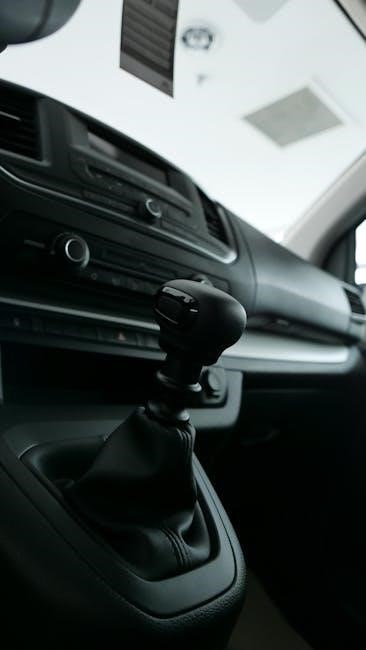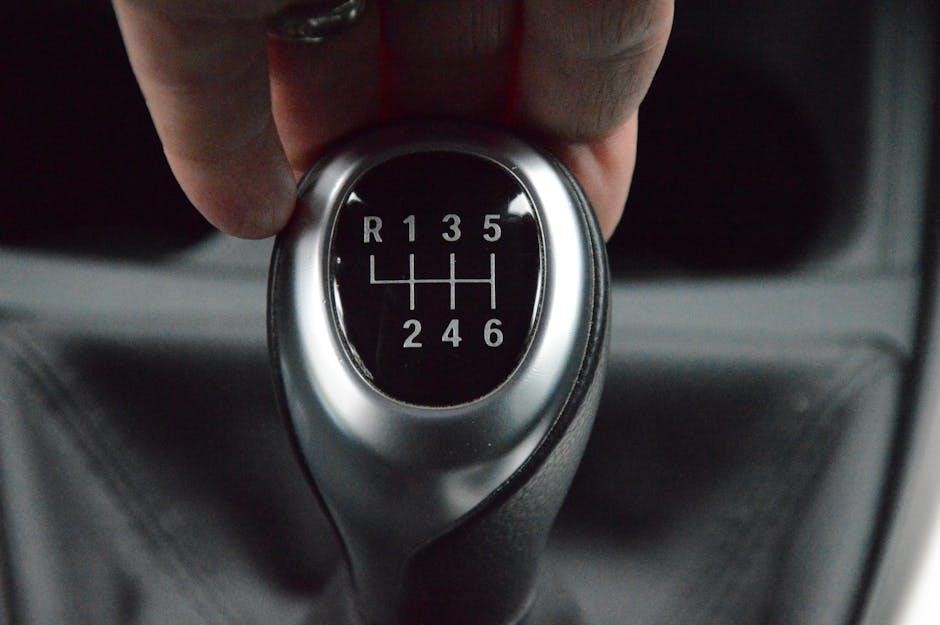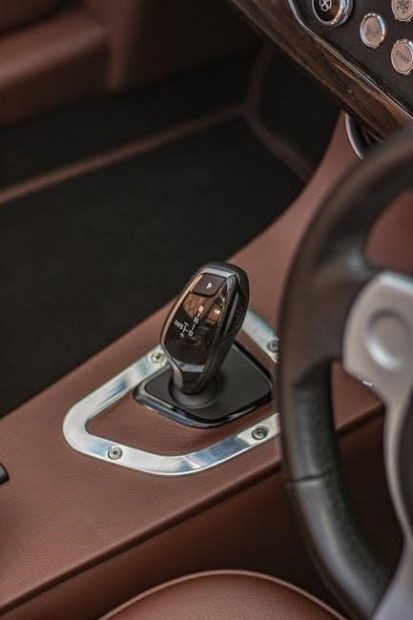History of RAM Manual Transmission
The RAM manual transmission traces its roots to the late 1980s, with early models offering robust, durable designs for work-focused trucks. By the early 2000s, manual transmissions like the NV4500 and NV5600 became synonymous with RAM’s heavy-duty lineup, particularly in trucks equipped with the 5.9L Cummins engine. These transmissions were celebrated for their reliability and torque-handling capabilities, making them a favorite among enthusiasts and professionals alike. However, as automatic transmissions gained popularity for their convenience, manual options gradually declined, with the last manual RAM trucks being produced in the mid-2010s.
1.1 Early Models and Evolution
The RAM manual transmission’s history began in the late 1980s, with early models featuring basic 5-speed units designed for durability and simplicity. By the early 1990s, the introduction of the Getrag 360 and NV4500 transmissions marked a significant leap in strength and capability, catering to the growing demand for heavy-duty trucks. The late 1990s saw the adoption of 6-speed manual transmissions, which became standard in models like the 1999 Dodge Ram 3500, paired with the 5.9L Cummins engine. This era solidified manual transmissions as a cornerstone of RAM’s lineup, offering unmatched control and torque management for both work and towing applications.
1.2 Popularity of Manual Transmissions in RAM Trucks
Manual transmissions in RAM trucks gained widespread popularity in the late 1990s and early 2000s, particularly among enthusiasts and professionals needing maximum control. The 5.9L Cummins engine, paired with the NV4500 or NV5600 transmissions, became iconic for their durability and torque-handling prowess. These setups were favored for heavy-duty towing and hauling, offering unmatched driver engagement. However, as automatic transmissions improved in efficiency and capability, manual transmissions gradually lost market share. Despite this, a loyal community of drivers continues to appreciate the tactile experience and performance benefits of manual transmissions in classic RAM models like the 1999 Ram 3500 and 2004 Ram SRT-10.

RAM Models with Manual Transmission
Notable RAM models with manual transmissions include the 1999 Dodge Ram 3500, 2004 Ram SRT-10, 2016 Ram Dually, and 2017 RAM 1500, each offering unique performance and durability.
2.1 1999 Dodge Ram 3500
The 1999 Dodge Ram 3500 stands out as a rare find, featuring a 5.9L Cummins I-6 engine paired with a 5-speed manual transmission. This combination offers exceptional torque and durability, making it a favorite for heavy-duty tasks. With its robust build and reliable performance, this model has become a sought-after choice for both collectors and enthusiasts. The manual transmission enhances driver control, especially in challenging conditions, while the Cummins engine delivers the power needed for towing and hauling. This truck exemplifies the legacy of RAM’s manual transmission heritage, blending strength and precision in a classic design.
2.2 2004 Dodge Ram SRT-10
The 2004 Dodge Ram SRT-10 is a high-performance powerhouse, equipped with an 8.3L Viper V10 engine and a 6-speed manual transmission. This unique combination delivers exhilarating acceleration and precise control, making it a standout in RAM’s lineup. The SRT-10 was designed for enthusiasts seeking a blend of power and driver engagement, with upgrades like a cold air intake and performance headers enhancing its capabilities. Its rarity and exceptional performance make it a sought-after collector’s item, showcasing RAM’s ability to merge brute strength with manual transmission finesse in a bold, aggressive package.
2.3 2016 Ram Dually
The 2016 Ram Dually, a heavy-duty truck, features a robust manual transmission designed for towing and hauling. Its durability and control make it ideal for demanding tasks. With a powerful engine, it delivers exceptional torque, enhancing performance. Enthusiasts appreciate its precise shifting and strength, making it a reliable choice for heavy-duty applications. This model stands out for its blend of power and manual transmission capability, appealing to those who value traditional driving experiences in a sturdy work vehicle. Its popularity endures among those needing a truck that combines strength with driver engagement.
2.4 2017 RAM 1500
The 2017 RAM 1500 offered a manual transmission option, primarily in specific trims like the Rebel, paired with the 3.0L EcoDiesel engine. This configuration provided drivers with a unique blend of fuel efficiency and hands-on control, appealing to enthusiasts. The manual transmission, typically a G56 unit, was known for its smooth shifting and durability. However, it was less common than automatics, making manual-equipped models rare. Despite its appeal, RAM discontinued the manual option in the 2018 model year, shifting focus to automatic transmissions for broader market preferences and technological advancements.

Engines Compatible with Manual Transmission
RAM trucks featured manual transmissions with the 5.9L Cummins I-6, 6.7L Cummins I-6 Bluetec, and 8.3L Viper V10 engines, known for their torque-handling capability and driver appeal.
3.1 5.9L Cummins I-6 Engine
The 5.9L Cummins I-6 engine, known for its durability and impressive torque, was a staple in RAM trucks paired with manual transmissions. Introduced in the late 1980s, it quickly gained popularity for its reliability and performance in heavy-duty applications. Trucks like the 1999 Dodge Ram 3500 and 2016 Ram Dually often featured this engine with manual transmissions such as the NV4500 and Getrag 360. The combination of the 5.9L Cummins and a manual transmission became a favorite among enthusiasts and professionals, offering unmatched control and towing capability. This pairing solidified the RAM’s reputation as a workhorse.
3.2 6.7L Cummins I-6 Bluetec Engine
The 6.7L Cummins I-6 Bluetec engine, introduced in 2007.5, marked a significant leap in power and efficiency for RAM trucks. Producing over 400 horsepower and 1,000 lb-ft of torque, it became a favorite for heavy-duty applications. This engine featured advanced emissions technology, including a diesel particulate filter and selective catalytic reduction, to reduce environmental impact. Paired with manual transmissions like the G56, it offered exceptional control and towing capability. Despite its strength, common issues like DPF clogging and SCR system maintenance arose. Nonetheless, the 6.7L Cummins remains a symbol of RAM’s commitment to diesel excellence.
3.3 8.3L Viper V10 Engine
The 8.3L Viper V10 engine, famously used in the 2004 Dodge Ram SRT-10, delivered unparalleled power with 500 horsepower and 525 lb-ft of torque. Derived from the iconic Dodge Viper, this engine brought exclusivity to RAM trucks. Paired with a 6-speed manual transmission, it offered a unique driving experience, blending high performance with tactile control. Aimed at enthusiasts, this combination emphasized raw power over practicality. Despite its impressive capabilities, the V10’s large size and high fuel consumption limited its broader appeal; Nonetheless, it remains a standout in RAM’s history, symbolizing a bold era of performance.

Types of Manual Transmissions in RAM Trucks
RAM trucks have featured various manual transmissions, including the Getrag 360, NV4500, NV5600, G56, and TR-6060. Each offers distinct capabilities for different power and torque needs.
4.1 Getrag 360 Transmission
The Getrag 360 transmission is a 5-speed manual gearbox known for its durability and smooth shifting. Commonly paired with the 5.9L Cummins engine in early RAM trucks, it offers excellent torque handling, making it ideal for heavy-duty applications. Its compact design and lightweight construction contributed to improved fuel efficiency and drivability. Despite its robustness, the Getrag 360 was eventually phased out in favor of more advanced transmissions like the NV4500, which offered better performance and higher torque capacity for larger engines.
4.2 NV4500 Transmission
The NV4500 is a 5-speed manual transmission renowned for its strength and reliability in RAM trucks. Introduced in the late 1990s, it replaced the Getrag 360, offering improved durability and torque capacity. Designed with a gear-driven design, it excelled in heavy-duty applications, particularly with the 5.9L Cummins engine. Commonly found in 1998.5-2002 RAM 2500 and 3500 models, the NV4500 became a favorite among diesel enthusiasts due to its robust construction and smooth shifting. While it required regular maintenance, its longevity and performance made it a staple in RAM’s manual transmission lineup.
4.3 NV5600 Transmission
The NV5600 is a 6-speed manual transmission introduced by RAM in the early 2000s. Known for its durability, it was paired with the 5.9L and 6.7L Cummins engines, enhancing torque delivery. This transmission was praised for its smooth shifting and heavy-duty capabilities, making it ideal for both towing and off-road use. Common in 2003-2012 RAM models, the NV5600 offered a significant upgrade over its predecessors, though it required meticulous maintenance to prevent issues like bearing wear. Its reputation as a workhorse solidified its place in RAM’s lineup.
4.4 G56 Transmission
The G56 is a 6-speed manual transmission introduced in 2007 for RAM trucks. It was designed to pair with the 5.9L and 6.7L Cummins engines, offering improved durability and performance. Known for its lightweight design, the G56 featured a removable bellhousing and dual-mass flywheel for smoother operation. It became a popular choice for towing and heavy-duty applications due to its robust construction and lower gear ratios. The G56 was a successor to the NV5600, addressing some of its limitations while maintaining the reputation for reliability. It remained a staple in RAM’s lineup until its discontinuation in favor of newer transmissions.
4.5 TR-6060 Transmission
The TR-6060 is a 6-speed manual transmission used in high-performance RAM models, such as the 2004 RAM SRT-10 with the 8.3L Viper V10 engine. Designed for heavy-duty applications, it featured a robust build with a high torque capacity, making it suitable for powerful engines. The TR-6060 included a dual-mass flywheel and a hydraulic clutch system for smooth operation. Despite its strength, it was eventually phased out in favor of newer transmissions like the G56. Its durability and performance made it a favorite among enthusiasts, particularly in modified or high-performance RAM trucks.

Maintenance and Repair of Manual Transmissions
Regular fluid changes, clutch inspections, and sealing checks are crucial. Addressing wear and tear early prevents major repairs and ensures optimal performance.
5.1 Best Practices for Maintenance
Regular maintenance ensures longevity and smooth operation. Check transmission fluid levels monthly, using the correct specifications for your RAM model. Inspect the clutch pedal for proper alignment and adjust as needed. Lubricate the shift linkage and inspect for wear. Replace the transmission fluid every 30,000 to 60,000 miles, depending on usage. Monitor for leaks around seals and gaskets. Avoid aggressive shifting to prevent wear on synchronizers. Keep the clutch engaged fully to reduce strain. For high-mileage vehicles, consider upgrading to synthetic fluid for better protection. Address any unusual noises promptly to prevent major repairs.
5.2 Common Signs of Transmission Trouble
Identifying transmission issues early prevents costly repairs. Common signs include slipping or hesitation between gears, difficulty engaging gears, and unusual noises like grinding or whining. Leaks around the transmission pan or bellhousing indicate worn seals. A burnt smell or discolored fluid suggests overheating or degradation. Shuddering or vibrations during acceleration may point to faulty bearings or misaligned components. Delayed or rough shifting, especially when accelerating or decelerating, can signal worn clutch packs or synchronizers. For high-mileage vehicles, these issues are more prevalent, emphasizing the need for timely inspection and fluid checks.
5.3 DIY vs. Professional Repair
While some manual transmission repairs can be tackled by skilled DIY enthusiasts, others require professional expertise. Simple tasks like fluid changes or adjusting the clutch can be done at home. However, complex issues such as rebuilding the transmission or replacing internal components often demand specialized tools and knowledge. Misaligned shifts or worn bearings may necessitate professional intervention to avoid further damage. High-mileage vehicles or severe problems like gear grinding typically require a mechanic’s expertise. Balancing cost, time, and technical difficulty helps determine whether DIY or professional repair is more appropriate for your RAM manual transmission needs.

Common Issues with RAM Manual Transmissions
RAM manual transmissions often face issues like gear grinding, bearing wear, and synchro damage. High-mileage models may experience leaks or clutch failure, requiring timely repairs.
6.1 NV4500 Transmission Problems
The NV4500 transmission, commonly found in late 90s to early 2000s RAM trucks, often experiences issues such as worn synchronizers, leading to gear grinding during shifts. High-mileage units may develop bearing wear, causing vibrations and noise. Additionally, the input shaft can become prone to damage, especially under heavy load conditions. While generally reliable, these problems often surface around the 150,000-mile mark, necessitating costly repairs. Proper maintenance, such as regular fluid changes, can help mitigate these issues, but once symptoms appear, professional intervention is typically required to restore functionality.
6.2 NV5600 Transmission Issues
The NV5600 transmission, introduced in the early 2000s for RAM trucks with the 6.7L Cummins engine, has faced several common issues. Synchronizer wear is prevalent, leading to difficulty engaging gears, especially in higher ranges. High-mileage units often experience bearing failure, causing loud noises and vibrations. The transmission’s input shaft can also weaken under heavy load conditions, such as towing or hauling. While the NV5600 is durable, these problems typically emerge around 150,000 miles. Regular fluid changes and proper maintenance can help extend its life, but once issues arise, professional repair or replacement is often necessary to restore performance.
6.3 High Mileage Considerations
High-mileage RAM manual transmissions require careful monitoring to ensure longevity. Beyond 150,000 miles, wear on synchronizers and bearings becomes common, leading to noisy operation and gear engagement issues. The input shaft may weaken under stress, especially in trucks used for towing or hauling. Regular fluid changes and clutch inspections are crucial to prevent premature wear. While these transmissions are built to last, high-mileage units often require rebuilds or replacements to maintain performance. Owners should prioritize maintenance to avoid costly repairs and extend the life of their manual transmission system.

Performance and Upgrades
RAM manual transmissions deliver robust performance, particularly with the 6.7L Cummins engine. Upgrades like K&N Cold Air Intake and BBK Throttle Body boost acceleration and towing, improving both responsiveness and fuel efficiency effectively.
7.1 Performance Upgrades for Manual Transmissions
Performance upgrades for RAM manual transmissions enhance power and efficiency. Upgraded components like K&N Cold Air Intake and BBK Throttle Body improve airflow, increasing horsepower and torque. Belanger Exhaust Headers and High-Flow Catalytic Converters reduce backpressure, boosting acceleration. These modifications optimize engine performance, especially with the 6.7L Cummins engine. Additionally, manual transmissions benefit from lightweight flywheels and performance clutches, improving responsiveness. Drivers can also install aftermarket shift kits for smoother, quicker gear changes. These upgrades not only enhance towing capacity but also deliver better fuel efficiency, making them ideal for both daily driving and heavy-duty tasks.
7.2 Impact of Manual Transmission on Fuel Efficiency
Manual transmissions in RAM trucks can improve fuel efficiency through better engine control, especially in city driving. However, modern automatics often match or exceed manual efficiency on the highway. The 6.7L Cummins engine with a manual transmission achieves up to 20 MPG combined, while automatics may offer slightly better highway ratings. Driver behavior significantly impacts efficiency, as manuals require more engagement. For consistent driving habits, manuals remain a viable option for balancing performance and economy, making them a preferred choice for those seeking control over their truck’s power delivery and fuel usage.

The Future of Manual Transmissions in RAM Trucks
Manual transmissions in RAM trucks may see a resurgence, as hinted by Dodge’s plans to reintroduce them in models like the Charger. Despite declining popularity, enthusiasts and specific powertrains could keep manuals relevant, even as electrification looms. The future remains uncertain but promising for those who value driver engagement and control.

8.1 Current Trends and Availability
Manual transmissions in RAM trucks have become increasingly rare, with current models largely favoring automatics. However, enthusiasts can still find manual options in select trims, such as the 2017 RAM 1500 with the 6.7L Cummins engine. The NV4500 and NV5600 transmissions remain popular among die-hard fans, though availability is limited. Recent sales data shows manual transmissions account for less than 2% of RAM purchases, reflecting broader industry trends. Despite this decline, Dodge has hinted at reintroducing manuals in future models, suggesting a potential resurgence for these beloved gearboxes.
8.2 Will Manual Transmissions Continue in RAM Trucks?

Manual transmissions in RAM trucks face an uncertain future as automatics dominate the market. While enthusiast demand persists, RAM has largely phased out manual options in recent years. However, Dodge has hinted at reintroducing manual transmissions in select models, potentially tied to niche performance or off-road-focused trims. The rise of electric vehicles may also influence this trend, with manuals possibly appearing in future EVs for a unique driving experience. For now, manual transmissions remain a rare but cherished option for die-hard fans of the brand.
